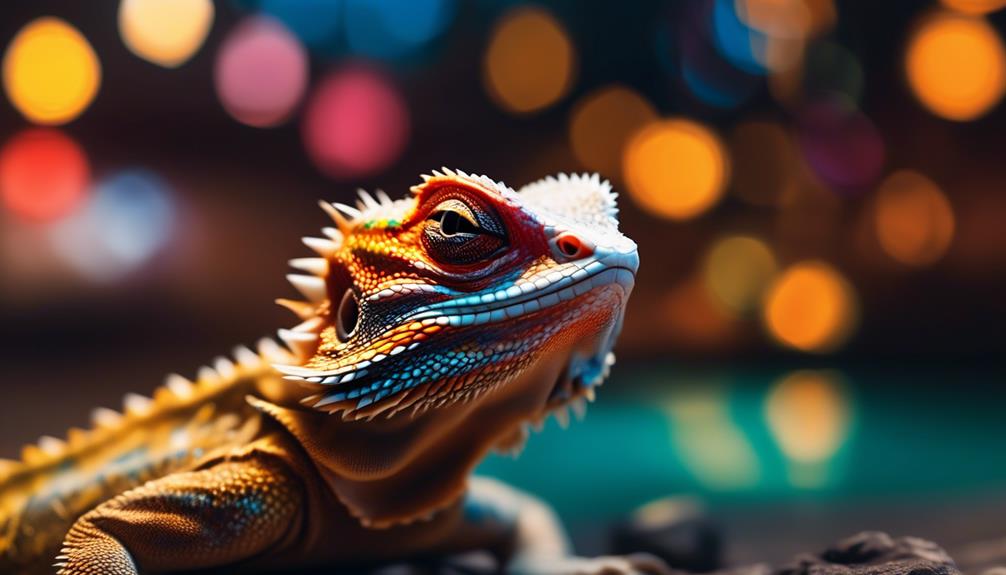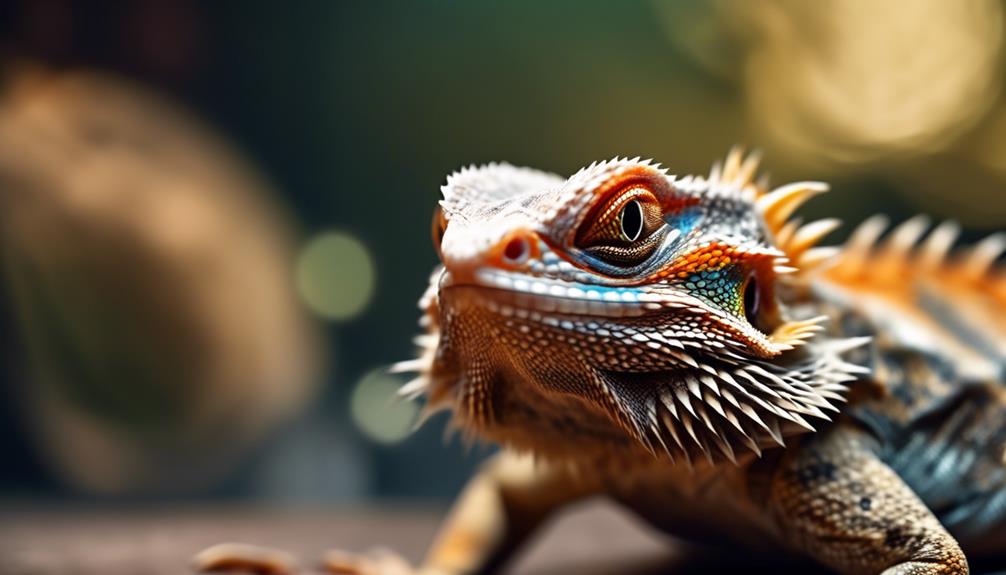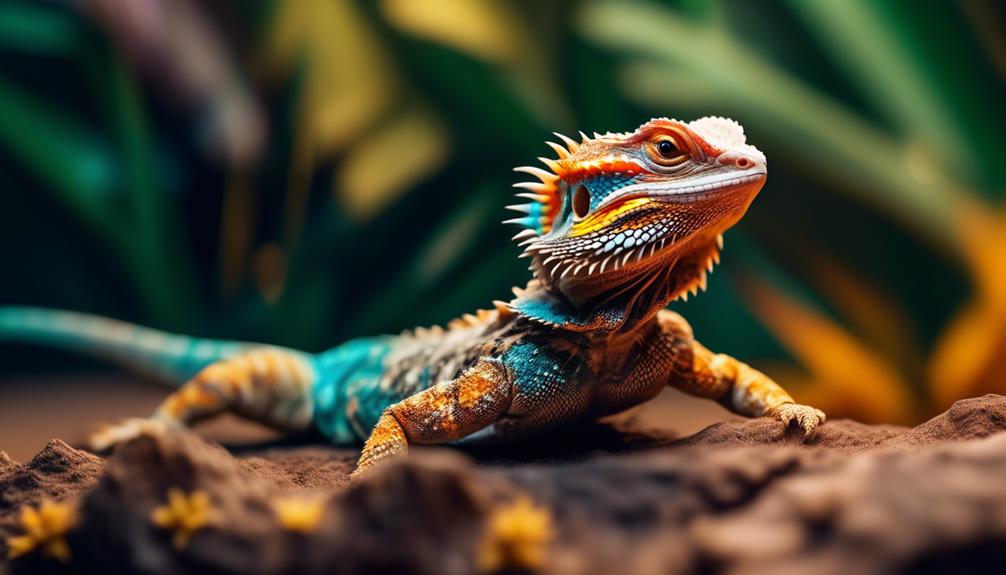Welcome, fellow explorers, to a journey of discovery into the captivating world of the bearded dragon's extraordinary eyesight. Like a key unlocking hidden realms of perception, their eyes hold secrets waiting to be unveiled.
In this discussion, we will uncover the marvels of their visual abilities, but the true wonders lie beyond what meets the eye. So, prepare to embark on an adventure where reality merges with imagination, where the extraordinary becomes tangible, and where the bearded dragon's gaze reveals a world beyond our wildest dreams.
Key Takeaways
- Bearded dragons have excellent eyesight for seeing things from a distance.
- They can see further into the spectrum of color than humans and use four cones for seeing color, increasing the number of colors they can perceive.
- Bearded dragons have a third eye (parietal eye) that detects shadows and changes in light, which is useful for detecting predators and determining the time of day.
- They have poor night vision compared to other animals and rely on other senses, such as their sense of smell, to navigate in low light conditions.
Bearded Dragons' Eyesight Abilities

Bearded dragons possess excellent eyesight, allowing them to see things from a distance with remarkable clarity. Their visual acuity is truly impressive, surpassing that of humans.
These reptiles can perceive a broader spectrum of colors, thanks to their four cones for color vision, compared to our three cones. This increased number of cones enables them to perceive a wider range of colors, enhancing their color perception abilities.
Additionally, bearded dragons have a third eye called the parietal eye, which detects shadows and changes in light. This adaptation is useful for detecting potential predators and determining the time of day.
With their exceptional visual acuity and enhanced color perception, bearded dragons have developed a remarkable ability to navigate their surroundings and adapt to their environment.
Bearded Dragons' Night Vision
With their exceptional visual acuity and color perception abilities, bearded dragons excel in navigating their surroundings during the day, but when it comes to nighttime, their vision becomes a challenge. Bearded dragons have poor night vision compared to other animals, making it difficult for them to see in the dark. However, they've adapted to low light conditions by relying on their other senses, such as their sense of smell, to navigate.
To improve their night vision, here are three strategies to consider:
- Providing supplemental lighting: Adding a low-wattage red or blue light to their enclosure can help enhance their visibility without disrupting their natural sleep cycle.
- Creating a dimly lit environment: Bearded dragons are more comfortable in dimly lit areas, so reducing the amount of light in their habitat can make it easier for them to see and move around during nighttime.
- Using reflective surfaces: Placing mirrors or reflective objects in their enclosure can help bounce light and improve their visibility in low light conditions.
Bearded Dragons' Depth Perception

Depth perception is a challenge for bearded dragons due to the positioning of their eyes on opposite sides of their head. This lousy depth perception can have a significant impact on their behavior. They may run into objects or misjudge distances, leading to potential injuries or jumping from unsafe heights.
Near-sighted bearded dragons face even more challenges when it comes to depth perception. They can see food but struggle to reach it, causing frustration when they can't access desired items.
To improve depth perception in near-sighted bearded dragons, there are several strategies that can be implemented. Placing feeders in a bowl instead of letting them roam can help, as well as using feeding tongs to wiggle treats, which improves their perception of food.
Challenges With Near Sightedness
Near-sightedness in bearded dragons presents unique challenges when it comes to their visual perception. As owners, we need to understand these challenges and find ways to assist our near-sighted dragons in their daily activities.
Here are a few strategies to consider:
- Using feeding tongs: Feeding tongs can be a helpful tool for our near-sighted dragons. By using tongs to wiggle their food, we can enhance their perception and make it easier for them to locate and catch their meals.
- Visual aids for near sightedness: Introducing visual aids in their enclosure can also be beneficial. Placing feeders in a bowl rather than letting them roam freely can help our dragons find their food more easily.
- Providing clear pathways: Creating clear pathways within their habitat can help our near-sighted dragons navigate without obstacles. This can prevent accidents and ensure their safety.
Importance of Visual Stimulation

Understanding the challenges of visual perception in near-sighted bearded dragons, it is crucial to recognize the importance of providing visual stimulation in their habitats. Visual stimulation plays a significant role in the behavior and well-being of these reptiles. By creating a visually stimulating environment, we can engage their natural hunting instincts, promote mental stimulation, and encourage physical activity.
To create a visually stimulating habitat, it is essential to incorporate a variety of colors and objects. This can be achieved by adding different types of plants, rocks, and hides. Additionally, regularly rearranging their habitat prevents boredom and promotes engagement.
To better understand the impact of visual stimulation on bearded dragons' behavior and well-being, let's take a look at the following table:
| Impact of Visual Stimulation | Strategies for Creating a Visually Stimulating Environment |
|---|---|
| Enhances natural hunting instincts | Incorporate a variety of colors and objects in the habitat |
| Promotes mental stimulation | Regularly rearrange the habitat to prevent boredom |
| Encourages physical activity | Provide climbing structures and obstacles |
| Prevents behavioral issues | Offer interactive toys and puzzles |
Frequently Asked Questions
Can Bearded Dragons See in the Dark Like Some Other Animals?
No, bearded dragons cannot see in the dark like some other animals. They have poor night vision and rely on other senses for nocturnal activity. This may impact their ability to navigate and participate in predator-prey interactions.
Is There a Specific Color That Bearded Dragons Cannot See?
Bearded dragons can see a wide range of colors, but they may have limited color perception in certain situations. Color blindness in bearded dragons is not well understood, and the role of UV light in their vision is still being studied.
How Does the Parietal Eye in Bearded Dragons Work?
The parietal eye in bearded dragons is a unique anatomical feature located on the top of their head. It functions as an additional light-sensing organ, detecting shadows and changes in light, aiding in predator detection and time perception. Its evolution is still a subject of scientific study.
Can Bearded Dragons Wear Glasses or Use Corrective Lenses for Their Near-Sightedness?
No, bearded dragons cannot wear glasses or use corrective lenses for their near-sightedness. Their eye anatomy and common eye problems make it challenging to provide visual correction. Other strategies like placing food in bowls or using feeding tongs may help.
Can Bearded Dragons Recognize Their Owners or Familiar Faces?
Bearded dragons can recognize their owners or familiar faces. By training bearded dragons through consistent interaction and positive reinforcement, their behavior can be shaped to associate certain individuals with positive experiences.
Conclusion
In conclusion, the bearded dragon's extraordinary eyesight is a marvel of nature. Their ability to perceive a broader spectrum of colors, coupled with their exceptional long-distance vision, surpasses our own capabilities.
However, their night vision and depth perception are lacking, presenting challenges in their daily lives.
Like a treasure hunter in a vast desert, exploring the bearded dragon's visual realm is a captivating journey that unveils the wonders hidden within their gaze.



